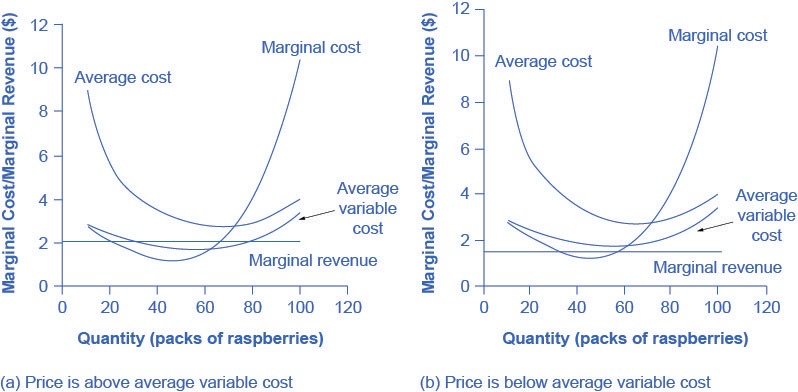Shutdown Point - Cost Curve
What is the Shutdown Point on The Cost Curve?
- Marketing, Advertising, Sales & PR
- Accounting, Taxation, and Reporting
- Professionalism & Career Development
-
Law, Transactions, & Risk Management
Government, Legal System, Administrative Law, & Constitutional Law Legal Disputes - Civil & Criminal Law Agency Law HR, Employment, Labor, & Discrimination Business Entities, Corporate Governance & Ownership Business Transactions, Antitrust, & Securities Law Real Estate, Personal, & Intellectual Property Commercial Law: Contract, Payments, Security Interests, & Bankruptcy Consumer Protection Insurance & Risk Management Immigration Law Environmental Protection Law Inheritance, Estates, and Trusts
- Business Management & Operations
- Economics, Finance, & Analytics
What is the Shutdown Point on The Cost Curve?
Shutting down can reduce variable costs to zero, but in the short run, the firm has already paid for fixed costs. As a result, if the firm produces a quantity of zero, it would still make losses because it would still need to pay for its fixed costs. Therefore when a firm is experiencing losses, it must face a question: should it continue producing or should it shut down?
When the firm is operating below the break-even point, where price equals average cost, it is operating at a loss so it faces two options: continue to produce and lose money or shutdown.
Which option is preferable? The one that loses the least money is the best choice.
The key reason is because price is above average variable cost. This means that at the current price the firm can pay all its variable costs, and have some revenue left over to pay some of the fixed costs.
So the loss represents the part of the fixed costs the firm can’t pay, which is less than the entire fixed costs.

The intersection of the average variable cost curve and the marginal cost curve, which shows the price below which the firm would lack enough revenue to cover its variable costs, is called the shutdown point.
If the perfectly competitive firm faces a market price above the shutdown point, then the firm is at least covering its average variable costs. At a price above the shutdown point, the firm is also making enough revenue to cover at least a portion of fixed costs, so it should limp ahead even if it is making losses in the short run, since at least those losses will be smaller than if the firm shuts down immediately and incurs a loss equal to total fixed costs.
However, if the firm is receiving a price below the price at the shutdown point, then the firm is not even covering its variable costs. In this case, staying open is making the firm’s losses larger, and it should shut down immediately. To summarize, if:
- price < minimum average variable cost, then firm shuts down
- price > minimum average variable cost, then firm stays in business
Related Topics
- Market Structure
- Perfect Competition
- Bidding War
- Complements & Substitutes
- Substitution Effect
- Imperfect Competition
- Market Power
- Price Takers
- Price Makers
- Perfect Competition and Decision Making
- X-Efficiency
- Captive Market
- Contestable Market Theory
- Highest Profit Point in a Perfectly Competitive Market
- Marginal Revenue
- Using Marginal Revenue and Marginal Costs to Maximize Profit
- Marginal Revenue Curve
- Profit Margin and Average Total Cost
- Break Even Point - Cost Curve
- Shutdown Point - Cost Curve
- Short-Run Decisions Based Upon Costs in a Perfectly Competitive Market
- Marginal Costs and the Supply Curve for a Perfectively Competitive Firm
- Long-Run Average Supply (LRAS)
- Decisions to Enter or Exit a Market in the Long Run
- Long-Run Equilibrium in a Perfectly Competitive Market
- Constant, Increasing, and Decreasing Cost Industries
- Productive and Allocative Efficiency in Perfectly Competitive Markets
- Market Efficiency
- Market Inefficiency
- Pareto Efficiency
- Market Failure
- Search Theory
- Monopoly
- Natural Monopoly
- Legal Monopoly
- Bilateral Monopoly
- Promoting Innovation through Intellectual Property
- Predatory Pricing
- How Monopolists Set Price with the Demand Curve
- Total Cost and Total Revenue for a Monopolist
- Marginal Revenue and Marginal Cost for a Monopolist
- Inefficiency of Monopoly
- Perfectly Competitive Market
- Monopolistic Competition
- Duopoly
- Oligopoly
- Differentiated Products
- Perceived Demand for a Monopolistic Competitor
- Monopolistic Competitors Choose Price and Quantity
- Monopolistic Competitors and Entry
- Monopolistic Competition and Efficiency
- Cartel (Economics)
- Game Theory
- Traveler's Dilemma
- Prisoner's Dilemma
- Iterated Prisoner's Dilemma
- Nash Equilibrium
- Diner's Dilemma
- Trembling Hand Perfect Equilibrium
- Gambler's Fallacy
- Arrows Impossibility Theorem
- Backward Induction
- Tournament Theory
- Oligopoly and the Prisoner’s Dilemma
- Forcing Cooperation in a Prisoner’s Dilemma
- Cooperation and the Kinked Demand Curve
- Corporate Merger or Acquisition
- Antitrust Laws
- Herfindahl-Hirschman Index
- Concentration Ratio
- Other Approaches to Measuring Monopoly Power in an Industry
- Restrictive Practices under Antitrust Law
- Natural Monopoly
- Cost-Plus Regulation
- Price Cap Regulation
- Regulatory Capture